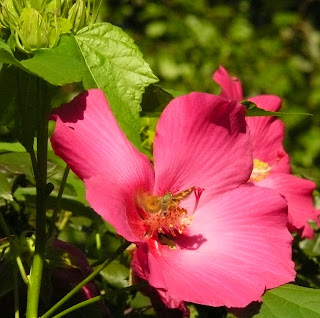Uncategorized
Hibiscus & Alicia
Guest Blogger: My Dear Friend Alicia visiting from the UK
My good friend HollyBeth has invited me to be a guest blogger today. This is an honor and joy because she is such a good friend, full of enthusiasm, hope and encouragement, and has been that way all the years I’ve known her. While visiting her over the weekend, we went on a lovely Sunday morning walk through her neighborhood. In this historic district of houses built in the 1940s, 50s and early 60s not only do these small charming homes brim with personality and architectural details but also have delightfully manicured front yards. And since I have seen HollyBeth’s back yard or, should I use the British way of saying it, her back garden, hers is an oasis of peace and beauty. The day began with a breakfast of tea, muffins and fresh fruit in the gazebo surrounded by quiet and stillness, with only birdsong filling the air and the green lushness of her plants surrounding us. Her back garden is truly a suburban gem. What a way to begin the day! It was such a relaxing treat to have these reflective moments.
Sunday was a beautiful day, basically clear skies with puffs of white cotton clouds floating by and every once in a while HollyBeth would squeal with excitement; “it’s such a beautiful day today. I cannot believe how blue the sky is!”
During our walk as we passed these colorful and well kept front yards, we saw bees and butterflies dancing from one bloom to the next. I had brought my little camera along in hopes of getting a few photos but really didn’t anticipate the luck I would have. What else should I have expected on such an incredibly beautiful, sunny day? Stopping now and again to capture a photo of a butterfly, bee or flower and also to catch a moment to “rest” a bit and appreciate the views, we were amazed at the variety of plants in people’s yards: Echinacea or coneflowers, Black-eyed Susans, tomato plants, summer squash, beans, sunflowers, moonflowers, morning glory, hibiscus, lantana, busy lizzies, begonias, roses, crape (crepe) myrtle, cosmos, sweet potato vine, zinnias, petunias and more … So many flowers that are bee, butterfly and insect pollinator friendly. And although dogwood season has passed and is not in bloom now, it is encouraging to see that dogwood is still a favorite tree to plant. I love the idea of planting vegetables alongside flowering plants. Not only is it creative but shows that no matter how small a plot is, or how novice a gardener you might be, everyone can have a little bit of homegrown organic goodness.
Something as simple as a neighborhood walk was inspiring and a positive way to start the day and the week and, most importantly, to spend time with a very good friend.
Hibiscus flowers are a genus of flowering plants in the mallow family which is quite large, containing several hundred species that are native to warm-temperate, subtropical and tropical regions throughout the world. Hibiscus are often noted for their showy flowers and are commonly known as hibiscus, sorrel, and flor de Jamaica, or less widely known as rosemallow.
It is also used in the production of food, such as yogurts, ice-creams, and butter with a wonderful aroma, hot and cold teas, jellies, sauces and syrup. The tea is popular as a natural diuretic; it contains vitamin C and minerals, and is used traditionally as a mild medicine. Hibiscus tea is enormously popular not only for relaxation use, but also in various treatments. Hibiscus tea tastes tart with cranberry-like notes. A 2008 USDA study shows consuming hibiscus tea lowers blood pressure in a group of prehypertensive and mildly hypertensive adults. Dieters or people with kidney problems often take it without adding sugar for its beneficial properties and as a natural diuretic. Its seeds are used in the production of vegetable oil in China Philippines
Various forms of the hibiscus are the national flower emblems of South Korea Malaysia

